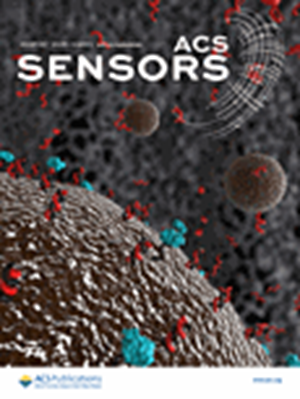Tunable and Stable Triplex DNA Structure for Surface Plasmon Resonance Detection of UV-Induced DNA Damage
IF 8.2
1区 化学
Q1 CHEMISTRY, ANALYTICAL
引用次数: 0
Abstract
Ultraviolet (UV) irradiation can destroy hydrogen bonds, leading to DNA deformation or destruction. Triplex DNA is produced by combining Watson–Crick and Hoogsteen base pairing under certain conditions. The UV-induced damage of target DNA may influence the triplex DNA formation; thus, a simple and sensitive surface plasmon resonance (SPR) assay of the DNA damage process was proposed. The experimental conditions for forming the triplex DNA were explored, and the stability comparison between duplex and triplex DNA was performed. The triplex DNA possessed higher stability under acidic pH and sufficient Mg2+, and the sequence length could remarkably influence its stability. By derivatization of the triplex structure with two biotin tags, the incorporation of streptavidin resulted in amplified SPR signals. However, UV-induced damage of biotinylated target DNA attenuated the triplex DNA formation, and smaller SPR signals were attained. The SPR signals were inversely and linearly dependent on the UV irradiation doses that represented the photodamage levels in the range of 0.117–1.75 kJ/m2, and the detection limit was estimated to be 0.039 kJ/m2. Through the competitive assay, UV-induced damage of unbiotinylated target DNA can also be detected. The proposed method serves as a viable means for the detection of UV-induced DNA damage based on the triplex DNA structure.

表面等离子体共振检测紫外线诱导DNA损伤的可调稳定三重DNA结构
紫外线(UV)照射可以破坏氢键,导致DNA变形或破坏。三重DNA是在一定条件下由沃森-克里克碱基和胡格斯汀碱基配对结合而产生的。紫外诱导的靶DNA损伤可能影响三联体DNA的形成;因此,提出了一种简单灵敏的表面等离子体共振(SPR)检测DNA损伤过程的方法。探讨了形成三联体DNA的实验条件,并对两种DNA的稳定性进行了比较。三联体DNA在酸性pH和充足的Mg2+条件下具有较高的稳定性,序列长度对其稳定性有显著影响。通过与两个生物素标签的三联体结构衍生化,链霉亲和素的掺入导致SPR信号放大。然而,紫外线诱导的生物素化靶DNA损伤减弱了三联体DNA的形成,获得了更小的SPR信号。在0.117 ~ 1.75 kJ/m2范围内,SPR信号与代表光损伤水平的紫外照射剂量呈负线性关系,检出限估计为0.039 kJ/m2。通过竞争分析,也可以检测到紫外线诱导的非生物素化靶DNA的损伤。该方法可作为一种可行的基于DNA三重结构的紫外损伤检测方法。
本文章由计算机程序翻译,如有差异,请以英文原文为准。
求助全文
约1分钟内获得全文
求助全文
来源期刊

ACS Sensors
Chemical Engineering-Bioengineering
CiteScore
14.50
自引率
3.40%
发文量
372
期刊介绍:
ACS Sensors is a peer-reviewed research journal that focuses on the dissemination of new and original knowledge in the field of sensor science, particularly those that selectively sense chemical or biological species or processes. The journal covers a broad range of topics, including but not limited to biosensors, chemical sensors, gas sensors, intracellular sensors, single molecule sensors, cell chips, and microfluidic devices. It aims to publish articles that address conceptual advances in sensing technology applicable to various types of analytes or application papers that report on the use of existing sensing concepts in new ways or for new analytes.
 求助内容:
求助内容: 应助结果提醒方式:
应助结果提醒方式:


